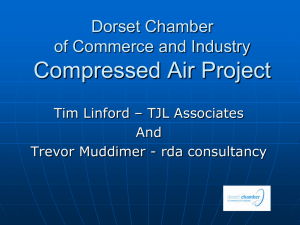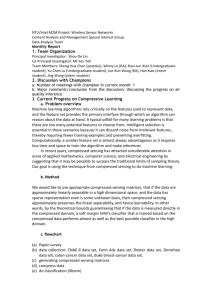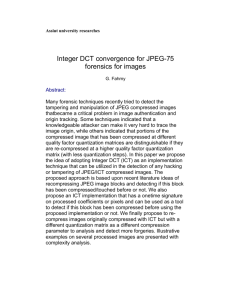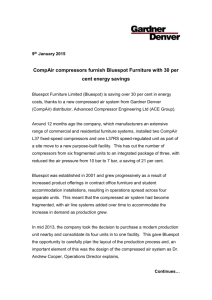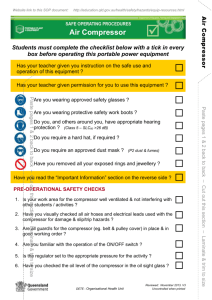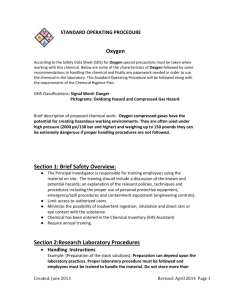Compressed air training programme (79KB, DOC)
advertisement
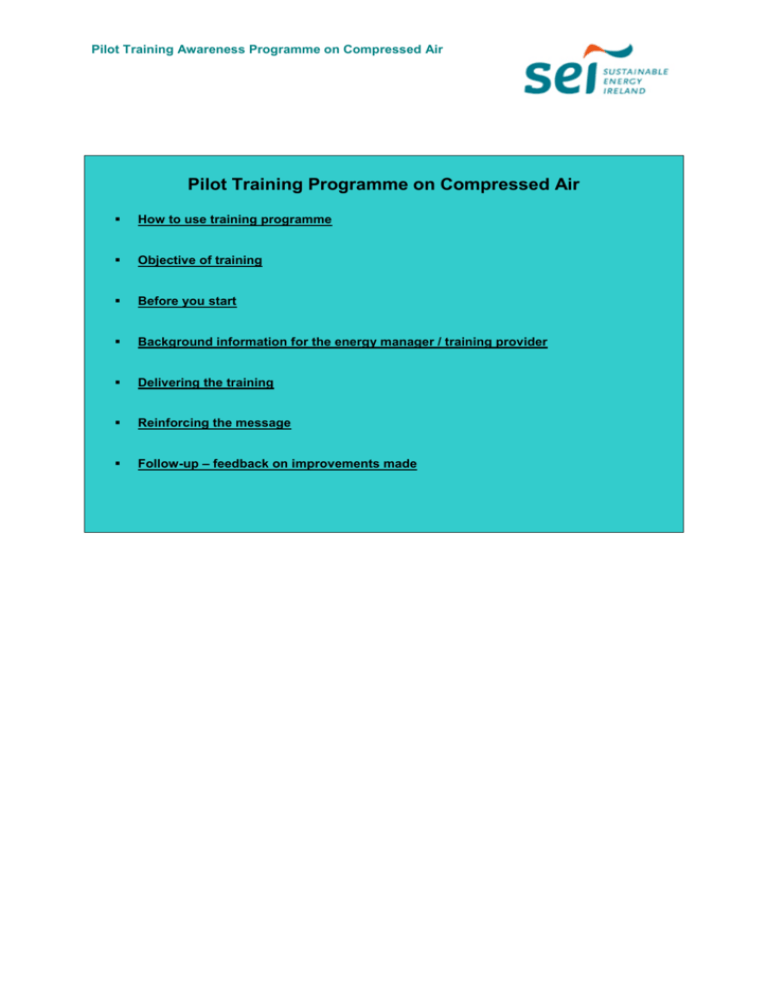
Pilot Training Awareness Programme on Compressed Air Pilot Training Programme on Compressed Air How to use training programme Objective of training Before you start Background information for the energy manager / training provider Delivering the training Reinforcing the message Follow-up – feedback on improvements made Pilot Training Awareness Programme on Compressed Air 1.1 HOW TO USE TRAINING PROGRAMME This programme is designed to help you the Energy Manager to create some Key Point Aim at staff who have responsibility w.r.t. compressed air awareness around the subject of compressed air. It is aimed at those members of staff who clearly have a responsibility with regard to compressed air. It should be used as part of an overall energy awareness programme so that it is delivered in context and following the training session the key learning points should be reinforced through other awareness raising tools so as to ensure a lasting message. 1.2 BEFORE YOU START Key Point What is the baseline - see how much staff know already Before you start implementing this programme, it is a good idea to see how much relevant staff know about compressed air already. This will give you some direction in adapting this training programme to best reflect your company’s needs. You can do this on an informal way by asking questions from a few key people or you could do a more formal survey. This should not be an onerous task but should provide you with enough information to give you a baseline of knowledge about compressed air. The following are some questions that you might ask: What is compressed air? What can it be used for? How much does compressed air operation cost the XXXX? (Give options) How do you know if there is a leak? What do you currently do if you identify a leak? 1.3 OBJECTIVE OF TRAINING By the end of this training course, the learners should Understand what compressed air is; Why it is important in terms of energy; Know how to detect and report leaks; Use compressed air in the appropriate way; Know who to contact should they have a query or an incident to report; Pilot Training Awareness Programme on Compressed Air You’re specific objectives may vary according to the baseline you have identified. 1.4 BACKGROUND INFORMATION FOR THE ENERGY MANAGER / TRAINING PROVIDER Appendix 1 (below) contains background information for the energy manager / training provider which may be useful in terms of preparing for the training session. Much of this information may already be known by the energy manager / training provider, however it has been endeavoured to provide streamlined information for the purpose of providing this training. 1.5 DELIVERING THE TRAINING Key Point Deliver through workshop enhanced by demonstration As already stated this training on compressed air should be delivered as part of a wider energy awareness campaign. It should not be delivered until some context has been set company-wide for energy awareness. The training should be delivered through a talk / workshop / seminar. It can be delivered as part of a wider seminar / workshop on other aspects of energy awareness or perhaps another issue that affects the staff relevant to compressed air. The talk would be enhanced by a demonstration e.g. how to identify a leak. The talk plus demonstration should take no longer than 45 minutes. The attached PowerPoint presentation can be used to deliver training on compressed air. It may need some adaptation to reflect needs / situation of your organisation this will give you the basis for delivering training to your staff on compressed air. Compressed Air PowerPoint Presentation Pilot Training Awareness Programme on Compressed Air 1.6 REINFORCING THE MESSAGE Key Point Use variety of tools to keep momentum going. Following the training session it is important to maintain some momentum so that the learning points of the session are carried through and you begin to see some improvement. You can do this by reminding learners of key points through a variety of communication media. Use the statistics in the background information on compressed air to draw up your communication materials. Use the below templates as your communication tools: Poster Template PowerPoint Template Newsletter Template 1.7 FOLLOW-UP – FEEDBACK ON IMPROVEMENTS MADE Key Point Let staff know how they have improved. It is important that you provide some form of feedback to your staff after a period of time to let them know how they improved. You can do this in a number of ways e.g. through another talk / seminar 6 months later outlining the statistics around improved management of compressed air. You could also use some of the above templates to get the message out there. Pilot Training Awareness Programme on Compressed Air Appendix 1 – Background Information Introduction Compressed air is an essential resource in the manufacturing industry and is often referred to as the fourth utility after electricity, oil and gas. The common misconception is that compressed air is free, while this may be true for the air we breather, when it is compressed by high pressures to produce this fourth utility, it can be up to ten times more expensive than electricity! Compressed air is used in a variety of operations and is a significant requirement in many industrial manufacturing plants to operate pneumatic tools and pneumatic controls. In many applications it is also used for product cleansing and blow-off applications. Placement of Compressors If compressed air is a definite requirement at your place of business, then the location of your compressor will play an important role in energy costs. This is due to the fact that in order to operate efficiently, a compressors air-intake needs to be kept cool to compress air effectively. When switched on, and even in stand-by mode compressors use up to 30% power. Where possible, it would be ideally suited to place your compressor so that it takes in external, colder air, most appropriately on the north wall of your building where the air temperature would be cooler. Using the coldest possible air source will maximise your compressor efficiency as reducing your air inlet temperature by 6 0C will increase your output by 2%. Cold air is more dense than warm air and hence takes less energy to compress it. If the compressor is taking in internal air it will have to work harder to compress the same amount of air hence ultimately increasing maintenance requirements and running costs. Another factor to consider in the placement of compressors is to remember that when in operation, compressors produce heat. In many installations this heat is vented to the atmosphere and wasted. If there is space and ducting available, this waste heat can be vented to the interior of the building to provide space heating and may provide support to the primary heating system. Capital and Running Costs Compressed air is an expensive utility! Most people think that the largest cost is the initial purchase price of the unit and the running costs are mostly maintenance – this is not true. Typically, lifetime costs (over a ten year period) for a compressed air unit can be divided as follows: Compressed Air - Lifetime Costs Operational (electricity) 75% Capital 15% Maintenance 10% Pilot Training Awareness Programme on Compressed Air As can be seen from the chart, the operational costs of the unit are those that need to be most carefully considered when purchasing. It is estimated that for every 100 units of electricity that go into a compressor only 10 units of compressed air are produced. If maintenance is neglected, this figure is likely to decrease and running costs will increase further. With this in mind, users should determine life-cycle costs when financing a compressed air unit. To get an estimation of running costs of your compressor per year, you can use the following formula, which should give you an indication of predicted costs: Size of Motor (kW) * Unit cost of Electricity (€) * Running Hours (hrs/year) It is also important to remember that compressors should be switched off overnight or at weekends. As a general rule, if there is no production, then the compressor should be powered off. If not, the compressor is left running to power air leaks and idling which can still consume up to 40% of full load capabilities. Efficient Use of Compressors As discussed above, overall system efficiency is the key to maximum costs savings. Compressors are most efficient when operating at full or near full load and air compressor efficiency generally increases with size. Poor part-load efficiency of compressors also means it is more efficient to run a smaller compressor at near full load than a larger compressor at low load. As a result, the correct sizing of a compressor to the service it is providing is vital to efficient operation. A regular maintenance program is also key to ensuring that your operational costs are minimised. For example, replacing an air intake filter could save significant amounts of energy, as blocked filters can restrict the airflow into a compressor, thus increasing the power usage and reducing efficiency. Another factor is to keep all coolers, radiators and ventilation grilles clean and clear to minimise compressor power use. The operating pressures of the unit and point(s) of work also need to be considered when ensuring maximum efficiency is gained from your compressor, as there will be a pressure drop from the unit to the point of use. A pressure drop occurs as the compressed air travels through the distribution pipework and these distribution losses can account for up to 10% losses, poor system performance and excessive energy consumption. One way to combat these losses is to make use of regulators and controls as the pressure demand varies across the system. To ensure greater efficiency and smaller distribution losses, another aspect that should be considered is to minimise all redundant pipework in the system. This will also contribute to a lesser likelihood of air leaks. Air Leaks Air leaks contribute to your high energy bills, with a typical leak rate on a site of up to 20%. One common way to detect air leaks is to walk around the plant and listen for leaks (preferably completed outside of production hours). This will identify major air leaks, however the majority of air leaks are those that cannot be heard! For this reason, it is suggested that each site should have a leak repair and reporting programme which involves a leakage survey being carried out on a regular basis to identify all leaks and following this a leak repair programme be initiated on a regular basis. Using ultrasonic leak detection equipment is the best way to locate all leaks. This can be hired or purchased from your compressed air system supplier or from a specialist company. Operators on the floor using compressed air usually are the first to realise there is a potential Pilot Training Awareness Programme on Compressed Air leak, however they do not realise the significant cost of this loss and might never report a leak to the facility manager. Operators should be made aware of this and should routinely check the system for leaks and regularly listen for major leaks when the background noise is quiet enough. If an operator hears a leak, they should report the location to the facility manager immediately. Inappropriate use of compressed air - Many users of compressed air have no idea how expensive it is and therefore can often waste or misuse it. Inappropriate uses of compressed air include ventilation and cleaning down workbenches, floors, machinery and personnel! Instead of using compressed air, look for alternative measures to complete the same task i.e. use fans for ventilation and brushes or vacuum cleaners for cleaning down at the end of the shift. If employees are made aware of the high cost of producing this utility and have alternative measures to utilise, then its inappropriate use could well be minimised. The above options are where the operator can be most effective in reducing compressed air use and cost at a site. If they are made aware of its cost and high energy demand to produce it through an awareness campaign, they could be very effective in reducing costs though minimising leaks and only using this utility where required. Other savings possible with compressed air are typically more detailed and technical and beyond the scope of the operator, but which the facility manger could undertake. There is also a Health & Safety factor to consider here as the misuse of high pressure at the point of use can be dangerous. Training The best way to achieve higher operating efficiencies is to increase and raise awareness among employees. Make sure that everyone knows the high cost of producing compressed air and continue to remind people to use it efficiently and only when needed and also that leaks cost money! SUMMARY ‘TOP TIPS’ 1. 2. 3. 4. 5. 6. Ensure correct compressor location Ensure correct sizing of compressor Estimate lifetime running costs as well as capital costs Implement a regular maintenance program Implement a leak monitoring and repair system Perform regular usage checks: Is there a redundant branch that could be switched off? Is the air needed at such a high pressure? Is the air being put to efficient use? 7. Increase awareness among employees


